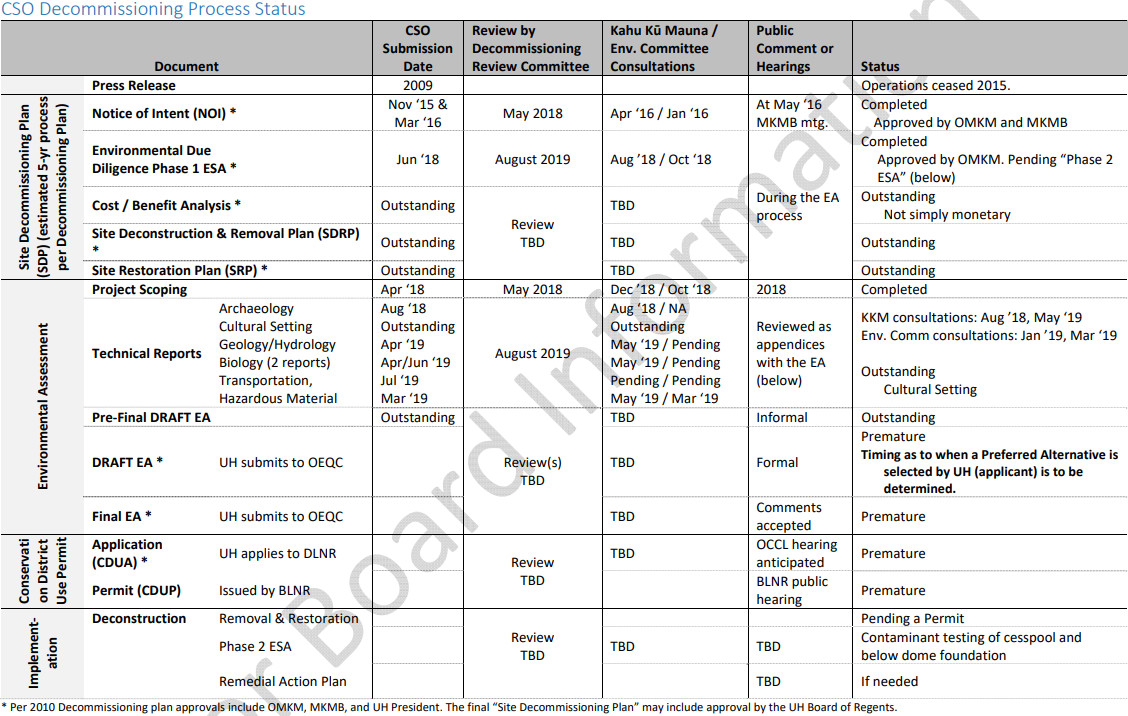(BIVN) – The process of decommissioning observatories on Mauna Kea was discussed at the Mauna Kea Management Board meeting held in Hilo on Tuesday.
Three observatories have so far been identified for decommissioning: Caltech Submillimeter Observatory, or CSO, and two University of Hawaiʻi-managed telescopes: Hoku Keʻa and UKIRT. The decommissionings are a condition of the Conservation District Use Permit to build the Thirty Meter Telescope. No new observatories will be constructed on those sites. At least two additional facilities will be permanently decommissioned by December 31, 2033, the CDUP states.
First, taking down CSO was discussed at Tuesday’s meeting. Office of Mauna Kea Management director Stephanie Nagata gave an overview of the decommissioning process, which was also covered in this submittal document:
Definition and Purpose (2010 Decommissioning Plan)
Decommissioning refers to a process that results in the partial or total removal of all structures associated with an observatory facility and the restoration of the site, to the greatest extent possible, to its preconstruction condition.
The decommissioning process guides the deconstruction of the observatory facility and its supporting infrastructure and restoration of the site. In addition to a funding plan, the four components of the process include (1) a Notice of Intent, (2) an environmental due diligence review, (3) a Site Deconstruction and Removal Plan and, (4) a Site Restoration Plan.
Brief Summary of Process and Requirements (2010 Decommissioning Plan)
The decommissioning process is successful when all regulatory compliance requirements are met and the site is deemed returnable to the State. A Site Decommissioning Plan (SDP) documents the condition of the site, outlines the approach to decommissioning, and proposes a plan for site restoration. The phases and specific details of the SDP are presented in the 2010 Mauna Kea Decommissioning Plan. An SDP should be submitted at least five years prior to either the termination date of a sublease, or a sublessee’s decision to cease operations, or as soon as is feasible if decommissioning is to take place less than five years after a decision is made to cease operations, whichever occurs first.
OMKM is responsible for overall coordination of the decommissioning process. OMKM will liaison with DLNR‐Office of Conservation and Coastal Lands (OCCL) as needed, will maintain all required reporting and documentation, and will provide DLNR‐OCCL with all relevant documentation. Deconstruction and site restoration efforts will be managed by the sublessees with oversight by OMKM. [The Department of Land and Natural Resources (DLNR) indicated that an Environmental Assessment (EA) and Conservation District Use Application (CDUA) and Permit (CDUP) will be required for CSO decommissioning. Caltech has also chosen to prepare subject‐matter specific technical reports to inform the preparation of the Site Decommissioning Plan and Environmental Assessment.]
The Board of Land and Natural Resources (BLNR) is the final authority regarding approval of the (Site) Decommissioning Plan.
There are several elements of the decommissioning process that will incorporate community input. A process similar to the Board of Regents‐approved Major Project Review Process will be established to review, guide and recommend the disposition of a site, including site restoration and planning.
Reviewers will include OMKM, Mauna Kea Management Board, Kahu Kū Mauna, and the Environment Committee [note: the review process also includes establishment of a technical group to review site‐specific documents, the “Decommissioning Review Committee”].
This table charting various aspects of the CSO Decommissioning Process Status was also provided:

from MKMB submittals
“This is going to be probably a difficult conversation,” commented MKMB member Julie Leialoha, “but I’m glad we’re starting it with regards to at least beginning the decommissioning process of this particular observatory.”
Board member Doug Simons also asked Nagata for an update on the decommissioning of the Hoku Kea telescope.
“Hoku Keʻa brought forth their Notice Of Intent To Decommissioning a few years ago,” Nagata began, “and there was quite a lot of public comments about … about not decommissioning this educational telescope. And so the University of Hawaiʻi-Hilo was asked to go out and consult with the community on this and in the meantime the UH-Hilo Astronomy Department was looking at other sites for Hoku Keʻa and … their research has indicated that the only place they can do it is, really, on Mauna Kea. Mauna Loa is not… it’s not a site they can use for various reasons. An area on Hualalai is not usable, it’s too low, and it has too much moisture, so it could damage the telescope.”
“They know that the summit is probably off-limits,” Nagata said, “so we’re looking at Halepohaku as a location. And so their initial conversations with a group that came forward against the decommissioning of Hoku Keʻa seems to be okay with Halepohaku.”

by Big Island Video News1:47 pm
on at
STORY SUMMARY
HILO, Hawaiʻi - The Mauna Kea Management Board on Tuesday shared updates on the plans to remove Caltech Submillimeter Observatory from the summit-area, and possibly relocate Hoku Keʻa to Halepohaku.